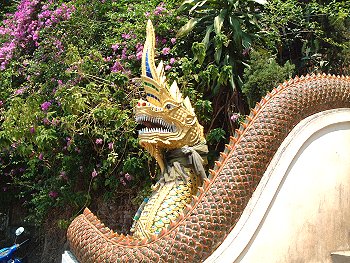Wat Prathat Doi Suthep
The temple of Wat Phra That Doi Suthep is
certainly one of the most important temples in Chiang Mai, as well as one of
the most revered among all Thais. The temple is a major pilgrimage destinations
during the important Buddhist holidays of Makha Buja and Visak. Its importance,
as well as its location, owes much to the legend of its founding.
According to this legend, a Buddha relic, which
some say glowed, magically replicated just before it was about to be enshrined
in the big chedi at Wat Suan Dok. The "cloned" relic was placed on the back of
a sacred white elephant, which was allowed to roam where-ever it wanted.
The elephant eventually climbed to the top of
Suthep Mountain, trumpeted three times, turned around three times, knelt down
and died. This was taken as a sign that this was the spot where the relic
wanted to be, so King Ku Na built the original of the chedi on Doi Suthep at
the end of 14th
The temple grew and changed in the 600 years
since its founding. In particular, it was extensively renovated in the economic
"boom" years of the early 1990's. From our admittedly western viewpoint, a lot
of the charm has been lost as everything was covered in granite and gold.
However, the temple remains an important sight that first-time visitors to
Chiang Mai shouldn't miss.
 The
chedi sits in a rather small courtyard at the very peak of the mountain. The
courtyard building sits on a larger plaza containing several buildings as well
as a lookout point from which you can see, weather permitting, all of Chiang
Mai and the surrounding plain. The
chedi sits in a rather small courtyard at the very peak of the mountain. The
courtyard building sits on a larger plaza containing several buildings as well
as a lookout point from which you can see, weather permitting, all of Chiang
Mai and the surrounding plain.
Among the buildings on the plaza is a small
museum displaying old pieces of temple wares as well as some of the more
ancient or unique monetary donations to the temple. Note that before entering
the courtyard containing the chedi, you must remove your shoes. You must also
be dressed appropriately, although the temple can provide some clothing on loan
to cover up your naughty knees and slinky shoulders.
Now for the bad news: To reach the temple itself
requires a climb up a naga staircase of 309 steps. For the faint of heart,
there's also a funicular cable-car to the top which has just been re-built
after several fatal crashes. The fare for the new improved funicular is 20
Baht.
At the base of stairs, where cars and motorcycles
park, there is a large market of food stalls, jade factories and endless
relentless souvenir sellers.
|
|
|
|